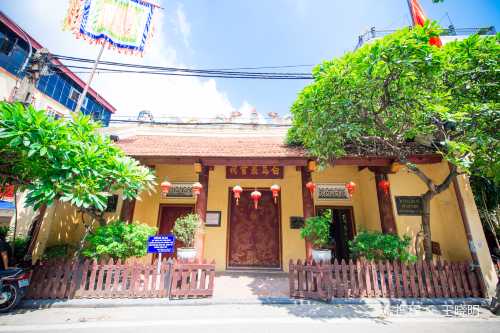Quan Thanh Temple: A Historical and Cultural Gem of Hanoi Overview Quan Thanh Temple (Đền Quán Thánh), also known as Tran Vu Temple, is one of Hanoi's oldest and most sacred Taoist temples. Established in the 11th century during the Ly Dynasty, it is part of the "Four Sacred Temples of Thang Long Citadel," guarding the northern entrance of the ancient capital. The temple is dedicated to Huyen Thien Tran Vu (Xuan Wu), the Taoist deity of the north, symbolized by a serpent and turtle. Located near West Lake at the intersection of Quan Thanh and Thanh Nien Streets, it remains a key spiritual and tourist site in Hanoi. Historical Significance - Founding: Built in 1010 under Emperor Ly Thai To to celebrate the relocation of Vietnam’s capital to Thang Long (modern Hanoi). - Sacred Role: One of four temples (alongside Bach Ma, Kim Lien, and Voi Phuc) positioned to protect the city from malevolent spirits and invaders. - Renovations: Restored multiple times, most notably in 1677 (when the iconic bronze statue was added) and 1893, blending Ly, Le, and Nguyen Dynasty architectural styles. Architecctural Highlights 1. Bronze Statue of Tran Vu: - Cast in 1677 by artisans from Ngũ Xã village, this 3.96-meter-tall, 3.6-ton black bronze statue depicts Tran Vu seated on a turtle, wielding a sword entwined by a serpent. It is Vietnam’s second-largest bronze statue and a masterpiece of 17th-century craftsmanship. - The deity’s symbols—the turtle (protection) and serpent (wealth)—reflect Taoist and Vietnamese folklore traditions. 2. Structural Features: - Three-Gate Entrance: Adorned with phoenixes and unicorns, typical of Nguyen Dynasty design. - Courtyard: Shaded by a centuries-old banyan tree, with a brick oven for burning joss paper during festivals. - Ancient Artifacts: Includes a 1.15-meter bronze bell, wood carvings of mythical creatures, and over 60 parallel poems in Chinese characters. Cultural and Spiritual Practices - Festivals: Locals visit during Tet (Lunar New Year) and on the 1st/15th lunar month days to pray for health, luck, and prosperity. - Syncretism: Though Taoist, the temple integrates Buddhist and Confucian elements, reflecting Vietnam’s religious blending. - Martial Arts: Hosts Vovinam classes, honoring Tran Vu’s association with martial prowess. Visitor Information - Location: 190 Quan Thanh Street, Ba Dinh District. - Hours: - Daily: 8:00 AM – 5:00 PM. - Extended hours on Tet Eve and lunar month days (6:00 AM – 8:00 PM). - Entry Fee: 10,000 VND (adults); 5,000 VND (students/children). - Dress Code: Modest attire covering shoulders and knees. Best Time to Visit: Early morning for tranquility, or during Tet (January–February) for vibrant rituals. Nearby Attractions 1. Tran Quoc Pagoda: Vietnam’s oldest pagoda, located on West Lake. 2. Ho Chi Minh Mausoleum: 1 km away, housing the embalmed leader. 3. Temple of Literature: Vietnam’s first university, dedicated to Confucius. Conclusion Quan Thanh Temple is a testament to Hanoi’s rich spiritual heritage and architectural ingenuity. Its iconic bronze statue, serene ambiance, and historical depth make it a must-visit for those exploring Vietnam’s cultural legacy. Whether admiring its artistry or participating in age-old rituals, the temple offers a profound glimpse into the soul of Hanoi. #travel #vietnam #hanoi #temple
Ice Lim 33
Popular Trip Moments
TICTACTOE | RIFF | MYOMI Brunch & Listening Room | RORU | The Running Bean | MATTE LATCHA | MORNING SIP | THE T CLUB | Hanoi | This Hanoi City Walk Guide Is All You Need | J’ADORE Cafe & Art Exhibition | TOMATSU | Á The Matcha Space | KIKU COFFEE | Hidden Local Cafe | Vietnam National Museum of Fine Arts | Vietnam Hanoi's Charming Cafe | Umami Bᾱm: Hanoi’s Must-Try for Sushi Lovers—Dine In or Takeout | Etēsia: Hanoi’s Most Stylish Dining Experience to Sweep Your Date Off Their Feet | Hoan Kiem Lake: The Timeless Soul of Hanoi | 6-day free tour in Hanoi | Vietnam – A Captivating Tapestry of Culture, Nature, and Flavor | Vietnam: A Tapestry of Culture, Cuisine, and Natural Wonder | TEMPLE OF LITERATURE | Vibes, Views, and Vietnamese Adventures | Embracing Comfort at Nyna Coffee | Vietnam Military History Museum | Hoa Lo Prison | Bat Trang Pottery Village | Exploring the Vibrant Heart of Hanoi | Discovering the Culinary Delights of Hanoi
Popular Travel Types
Recommended Attractions at Popular Destinations
Bangkok attraction near me | Manila attraction near me | Tokyo attraction near me | Taipei attraction near me | Hong Kong attraction near me | Seoul attraction near me | Kuala Lumpur attraction near me | Los Angeles attraction near me | Shanghai attraction near me | New York attraction near me | Shenzhen attraction near me | Osaka attraction near me | Singapore attraction near me | London attraction near me | Guangzhou attraction near me | San Francisco attraction near me | Beijing attraction near me | Macau attraction near me | Bali attraction near me | Jakarta attraction near me | Paris attraction near me | Ho Chi Minh City attraction near me | Istanbul attraction near me | Phuket attraction near me | Chicago attraction near me | Seattle attraction near me | Toronto attraction near me | Orlando attraction near me | Cebu attraction near me | Chiang Mai attraction near me
Popular Restaurants in Hanoi
The Gourmet Corner | Essence Restaurant | Red Bean Ma May | HOME Vietnamese Restaurant | Cha Ca Thang Long | Lu Wang carp | Quan An Ngon | d'LIONS Restaurant | Gia Restaurant | Pho 10 Ly Quoc Su(Co So 1) | Maison Sen | Highway4 Bar Restaurant | Cau Go Restaurant | Salt n' Lime | JW Cafe | Bamboo Bar | Hotpot Story Restaurant | Banh Cuon Gia Truyen | La Salsa Tapas bar&Restaurant | Stellar Steakhouse | Hibana by Koki | Mediterraneo | Cafe Duy Tri | Com Chay Nang Tam | ERA RESTAURANT | Tiem Com Mot Ngay Moi New Day Restaurant | French Grill | Banh Mi 25 | Duong's Restaurant & Cooking Class | Viet Restaurant
Popular Ranked Lists
Popular Best Things to Do in Long'an | Popular Trending Restaurants in Shanghai | Popular Best Things to Do in Zhaoping | Top 4 Best Things to Do in Guigang | Top 18 Local Restaurants in Gold Coast | Popular Premium Hotels Near Bintulu Division | Popular Trending Restaurants in Bali | Popular Premium Hotels in Fahaheel | Popular Luxury Hotels Near Recreio dos Bandeirantes | Top 9 Local Restaurants in Liuyang | Top 3 Best Things to Do in Yuyao | Top 6 Local Restaurants in Huainan | Top 3 Best Things to Do in Linxia Prefecture | Popular Best Things to Do in Anyue | Popular Premium Hotels in Miches | Popular Best Things to Do in Ziyang | Popular Premium Hotels in Korcula | Popular Best Things to Do in Zhuji | Popular Best Things to Do in Lichuan | Top 9 Local Restaurants in Lushan Global Geopark | Popular Best Things to Do in Zhongxiang | Popular Premium Hotels in Mbabane | Top 10 Local Restaurants in Adelaide | Popular Local Restaurants in Baoting | Popular Premium Hotels in Habaraduwa | Popular Luxury Hotels Near Bridgewater | Popular Best Things to Do in Wuhai | Top 3 Best Things to Do in Zaozhuang | Top 18 Local Restaurants in Da Nang | Top 5 Local Restaurants in Qujing
Payment Methods
Our Partners
Copyright © 2025 Trip.com Travel Singapore Pte. Ltd. All rights reserved
Site Operator: Trip.com Travel Singapore Pte. Ltd.
Site Operator: Trip.com Travel Singapore Pte. Ltd.














